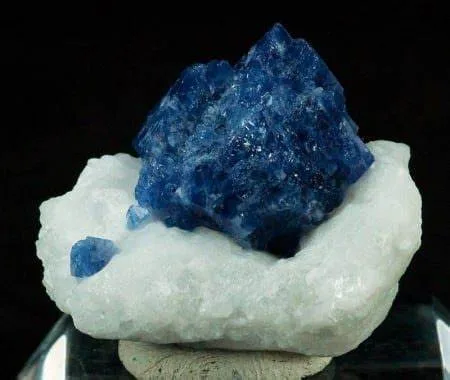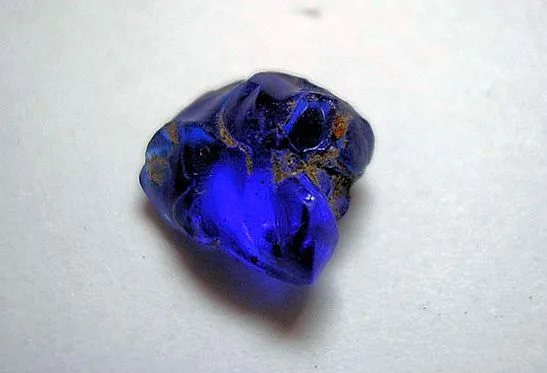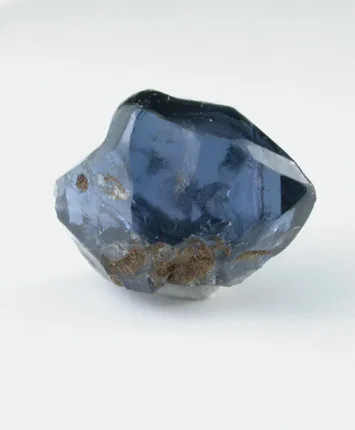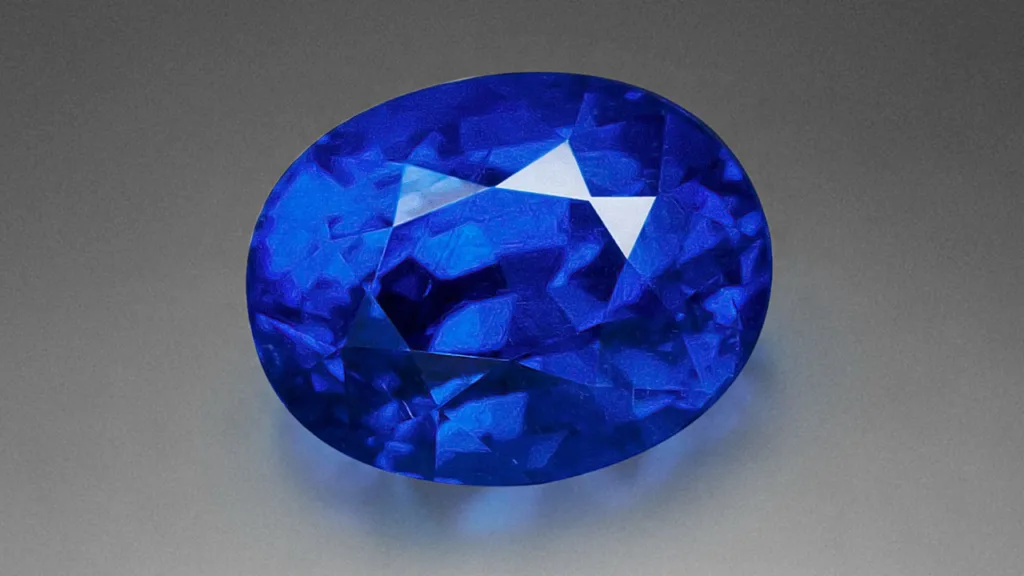Gahnospinel is a mineral belonging to the spinel group, which is a class of minerals with the general formula AB₂O₄. In gahnospinel, A represents a divalent metal cation, typically zinc (Zn²⁺), and B represents a trivalent metal cation, often aluminum (Al³⁺). The mineral has a cubic crystal structure and is characterized by its distinct colors and optical properties.


Discovery and Naming: Gahnospinel was first discovered and described by the Swedish chemist and mineralogist Johan Gottlieb Gahn in the late 18th century. Gahn is known for his contributions to the understanding of various minerals and elements. He named the mineral “gahnospinel” in recognition of his own name and its classification as a spinel mineral.
Johan Gottlieb Gahn: Johan Gottlieb Gahn (1745–1818) was a prominent Swedish chemist and mineralogist. He is most famous for his work on discovering manganese in the mineral pyrolusite and for isolating manganese metal. His contributions to mineralogy and chemistry laid the foundation for our understanding of various elements and compounds.
The Naming Process: The naming of minerals often involves a combination of the discoverer’s name, the mineral’s physical characteristics, its chemical composition, or its geographical location. In the case of gahnospinel, the name reflects both the mineral’s composition as a spinel and its connection to Johan Gottlieb Gahn, who made significant contributions to the field of chemistry and mineralogy.
Characteristics of Gahnospinel: Gahnospinel is known for its cubic crystal structure and often occurs in various colors, including black, brown, red, and green. It can exhibit a vitreous to resinous luster and may be transparent to opaque. The mineral’s distinctive colors and optical properties make it of interest to mineral collectors, researchers, and those in the jewelry industry.
Physical Characteristics

- Color: Gahnospinel can exhibit a range of colors, including black, brown, red, and green. The color variation is due to the presence of different transition metal ions in its crystal structure.
- Luster: The mineral’s luster is typically vitreous to resinous, giving it a somewhat shiny appearance.
- Transparency: Gahnospinel can be transparent, translucent, or opaque, depending on the specific composition and impurities present.
Crystal Structure and Symmetry:
- Gahnospinel crystallizes in the cubic crystal system, meaning its crystal structure is characterized by equal sides and 90-degree angles between them.
- Its crystal symmetry is generally referred to as isometric or cubic, which indicates that it has rotational symmetry of 4-fold or higher around each axis.
Hardness, Cleavage, and Fracture:
- Hardness: Gahnospinel has a relatively high hardness on the Mohs scale, typically ranging from 7.5 to 8. This makes it quite resistant to scratching, and it can scratch minerals of lower hardness.
- Cleavage: Gahnospinel does not exhibit distinct cleavage planes due to its cubic crystal structure. Instead, it tends to fracture along irregular, conchoidal surfaces.
- Fracture: The mineral’s fracture is usually conchoidal, meaning it breaks with curved, smooth surfaces resembling the shape of a shell. This type of fracture is common in materials with brittle characteristics.
Optical and Magnetic Properties:
- Optical Properties: Gahnospinel’s optical properties can vary depending on factors such as color and composition. It may display isotropic behavior, meaning that its properties remain constant regardless of the direction of observation under a polarizing microscope.
- Magnetic Properties: Gahnospinel is not typically strongly magnetic. Its magnetic behavior, if present, would be influenced by the specific transition metal ions present in its composition.
It’s important to note that the specific properties of gahnospinel can vary based on its exact chemical composition, impurities, and crystal growth conditions. To obtain accurate and detailed information about these properties, referring to scientific literature, mineral databases, or expert analyses is recommended.
Geological Occurrence

Types of Geological Environments: Gahnospinel can be found in a variety of geological settings, often associated with metamorphic and igneous environments. Some common types of geological environments where gahnospinel is found include:
- Metamorphic Rocks: Gahnospinel can form during high-temperature and high-pressure metamorphic processes, especially in regions where rocks undergo significant changes due to tectonic forces.
- Skarn Deposits: Skarns are contact metamorphic zones where hydrothermal fluids interact with carbonate rocks. Gahnospinel can be a product of such interactions.
Associations with Other Minerals or Rock Formations: Gahnospinel is often found in association with other minerals that are indicative of specific geological conditions. Depending on the geological context, it may be associated with minerals such as:
- Garnet: Gahnospinel can occur alongside garnet in metamorphic rocks and skarn deposits.
- Pyroxenes: In igneous rocks or certain metamorphic environments, gahnospinel might be found with pyroxene minerals.
- Spinel Group Minerals: Gahnospinel belongs to the spinel mineral group, so it can be found alongside other spinel minerals in various geological settings.
Locations Around the World with Significant Deposits: Gahnospinel deposits have been identified in various regions worldwide, and their significance can vary based on factors such as mineral quality and accessibility. Some notable locations include:
- Sweden: Given that gahnospinel was first described by Johan Gottlieb Gahn, Swedish deposits could be significant historically.
- Russia: Gahnospinel deposits have been reported in parts of Russia, often associated with metamorphic rocks.
- Italy: Some Italian localities have yielded gahnospinel-bearing rocks, particularly in metamorphic terrains.
It’s important to note that the availability of detailed information on gahnospinel’s geological occurrence can be limited, as it might not be a well-studied mineral compared to more common minerals. For the most accurate and up-to-date information on specific deposits and occurrences, consulting geological literature, mineral databases, and reports from geological surveys is recommended.
Formation and Genesis

Processes Involved in Formation: The formation of gahnospinel involves complex geological processes that occur over long periods of time. While the exact details may vary based on the specific geological setting, gahnospinel is generally formed through the following processes:
- Metamorphism: Gahnospinel can form during regional metamorphism, which involves high temperatures and pressures deep within the Earth’s crust. Under these conditions, minerals in pre-existing rocks undergo changes in their composition and crystal structure. Gahnospinel can crystallize from mineral precursors assemblages that are subjected to specific temperature and pressure conditions.
- Hydrothermal Alteration: In some cases, gahnospinel can form through hydrothermal alteration, where hot, mineral-rich fluids interact with existing rock. This process can occur in contact zones between different rock types or along fault lines, allowing the introduction of elements necessary for gahnospinel formation.
Geological Conditions Necessary for Formation: The formation of gahnospinel is influenced by specific geological conditions, including:
- Temperature and Pressure: Gahnospinel formation typically occurs at high-temperature, high-pressure conditions. These conditions are often found in regions undergoing regional metamorphism or in contact metamorphic zones.
- Mineral Assemblages: The presence of certain minerals, such as garnet and pyroxene, can be indicative of the geological conditions that favor gahnospinel formation.
- Fluid Interaction: Hydrothermal fluids, often associated with magma intrusions or fluid migration, can introduce the necessary elements for gahnospinel formation in certain environments.
Metamorphic, Igneous, or Other Origins: Gahnospinel can originate in both metamorphic and igneous environments, though its formation is more commonly associated with metamorphism. The specific origin depends on the prevailing geological conditions:
- Metamorphic Origin: Gahnospinel is commonly formed during regional metamorphism, where rocks are subjected to intense heat and pressure over large areas. This can occur in the deep crust or during tectonic processes.
- Igneous Origin: In some cases, gahnospinel can be associated with igneous activity, particularly in situations where hydrothermal fluids interact with magma. However, this origin is less common compared to metamorphic formation.
- Hydrothermal Origin: As mentioned earlier, gahnospinel can also form through hydrothermal alteration processes, often in skarn deposits where hydrothermal fluids interact with carbonate rocks.
It’s important to emphasize that the formation of gahnospinel is influenced by a combination of factors, including the mineral’s composition, the availability of necessary elements, temperature-pressure conditions, and the geological history of the region. As research continues, a more detailed understanding of the precise formation processes and origins of gahnospinel in different geological contexts may emerge.
Industrial and Practical Uses

Applications in Various Industries: Gahnospinel possesses several properties that make it valuable for various industrial applications, including:
- Ceramics and Refractories: Gahnospinel’s high hardness, resistance to high temperatures, and chemical stability make it suitable for use in ceramics, refractories, and kiln linings. It can withstand the extreme conditions of heat and abrasion.
- Electronics: Due to its electrical insulating properties and resistance to thermal shock, gahnospinel can be used in the electronics industry, particularly for insulating components in high-temperature environments.
- Abrasives: Gahnospinel’s hardness and durability make it suitable for use as an abrasive material in grinding and polishing applications.
Unique Properties: Several unique properties of gahnospinel contribute to its value in industrial applications:
- High Hardness: Gahnospinel’s hardness, often comparable to that of natural spinel or sapphire, makes it suitable for use in abrasive applications and as a component in wear-resistant materials.
- Thermal Stability: Gahnospinel can withstand high temperatures without significant deformation or deterioration, making it useful in high-temperature environments.
- Chemical Inertness: Its resistance to chemical reactions makes it suitable for use in chemically aggressive environments, such as in the manufacturing of chemical-resistant ceramics.
Comparison with Other Minerals: Gahnospinel’s properties and applications can be compared with other minerals with similar uses:
- Alumina (Al₂O₃): Like gahnospinel, alumina is used in ceramics and refractories due to its high melting point and chemical stability. However, gahnospinel’s high hardness can provide certain advantages in specific applications.
- Zirconia (ZrO₂): Zirconia is another material used in ceramics, refractories, and electronics due to its high temperature resistance and electrical insulating properties. Gahnospinel’s properties could make it an alternative in certain situations.
- Corundum (Al₂O₃): Corundum is used as an abrasive due to its hardness. Gahnospinel’s hardness and resistance to high temperatures might position it as a viable alternative in abrasive applications.
While gahnospinel offers unique properties, the choice of material for specific applications depends on factors such as availability, cost, performance requirements, and the specific conditions the material will be subjected to. Advances in material science may lead to further exploration of gahnospinel’s potential in various industries.
Gahnospinel in Jewelry and Gemology

Gemstone Quality Gahnospinel and Its Characteristics: Gahnospinel can be cut and polished to create gemstones, particularly for use in jewelry. Gem-quality gahnospinel exhibits certain characteristics that make it appealing to both gem enthusiasts and jewelry designers:
- Color Variety: Gahnospinel can display a range of attractive colors, including black, brown, red, and green. The variety in color provides options for creating unique and visually appealing jewelry pieces.
- Luster: Polished gahnospinel gemstones exhibit a vitreous to resinous luster, contributing to their overall visual appeal.
- Transparency: Gem-quality gahnospinel can be transparent to translucent, allowing light to pass through and enhancing the stone’s sparkle.
- Hardness: With a hardness of 7.5 to 8 on the Mohs scale, gahnospinel is durable and resistant to scratching, making it suitable for everyday wear.
Use in Jewelry and Ornamental Objects: Gem-quality gahnospinel can be used in various types of jewelry and ornamental objects:
- Rings: Gahnospinel’s hardness makes it suitable for rings that are subject to everyday wear. It can be used as a center stone or accent gem.
- Earrings: Gahnospinel can be used as stud earrings, drops, or dangles, adding color and elegance to earring designs.
- Pendants and Necklaces: Gemstone quality gahnospinel can be set in pendants, necklaces, and other hanging ornaments to create eye-catching jewelry pieces.
- Bracelets: Its durability makes gahnospinel suitable for use in bracelets that may come in contact with surfaces.
Market Trends and Consumer Interest:
- Unique Appeal: Gahnospinel’s varied colors and high hardness make it an attractive option for those seeking unique and durable gemstones.
- Interest in Alternative Gems: As consumers look beyond traditional gemstones, interest in less common gems like gahnospinel is growing. People are seeking stones that stand out and have a distinctive character.
- Custom Jewelry: Jewelry designers are increasingly using gahnospinel to create custom pieces, catering to clients who want personalized, one-of-a-kind jewelry.
- Aesthetic Value: Gahnospinel’s color range allows for creative designs and combinations with other gems, enhancing its appeal for both modern and classic jewelry styles.
However, it’s important to note that the availability of gem-quality gahnospinel may be limited compared to more widely known gemstones. As with any gemstone, purchasing from reputable sources and obtaining a certification from gemological laboratories can ensure the quality and authenticity of the stone.




































